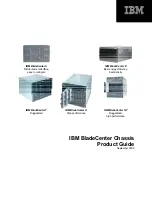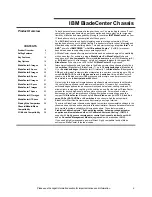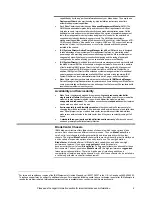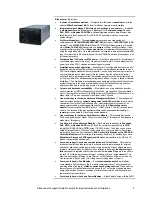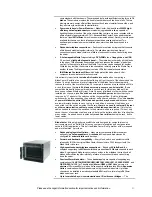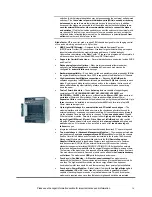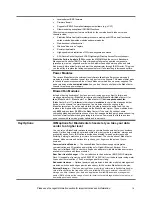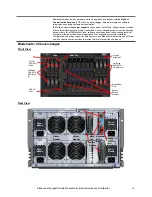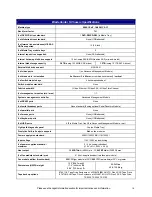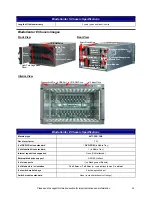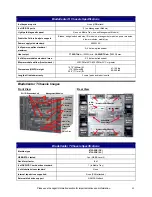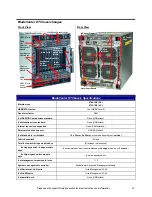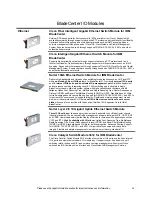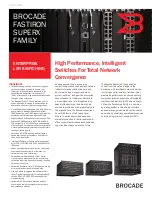
•
Two
hot-swappable Media Trays
each
contain
two
external
USB 2.0
ports, a
light path
diagnostic panel
, and support a
1GB/4GB compact flash (CF) option
— The media
trays are
shared by all the blades
in the server. This reduces unnecessary parts (and
reduces the number of parts than can fail). In the event of a failure of the Media Tray the
tray can be swapped for another. While the tray is offline, the servers in the chassis can
remotely access the Media Tray in another chassis. The diagnostic panel contains LEDs
that indicate chassis status. One media tray comes standard (without compact flash); an
optional second one provides redundancy. The CF option can act as a boot device,
eliminating the need for HDDs in the blades.
•
Redundant midplane connections
— Each chassis contains a midplane that connects
all blades and modules together internally. The midplane provides
two
physical
connections to each blade; therefore, a failure of one connector alone cannot bring down
the server.
•
Long-life availability
— The BladeCenter HT chassis offers an extended product lifecycle
(
3
years in production from date of General Availability, plus another
5
years of support).
This allows telecom Network Equipment Manufacturers (NEPs) and, Service Providers
(SPs) to standardize on a configuration for longer than traditional enterprise platforms.
Product availability for periods longer than 3 years will be handled on an individual basis.
•
It is extremely important to
include
all
infrastructure costs
when comparing a
BladeCenter HT solution to a competitor’s offering, not just the cost of the chassis and the
blades. The high density and level of integration of the BladeCenter HT chassis can
greatly reduce the cost of the overall solution. For example, because up to
8
(
1Gb
and
10Gb
) Ethernet, Myrinet, Fibre Channel, InfiniBand or other bridges and switches can be
installed
per chassis
,
up to 24 switches and bridges can be installed per rack
without
having to reserve any “U” space for the switches, unlike the competition. (And the
integrated switches may be less expensive than external, self-powered switches.) Plus,
the number of power distribution units (PDUs) needed per rack may be lessened
,
because there are fewer discrete devices to have to plug in. In addition, because all the
blades are connected to all the switches inside the chassis,
there is no need for external
Ethernet or other communication cables to connect the blades, bridges and
switches
. (Only the few cables needed to connect the switches to the external world are
required.) This not only saves the cost of numerous cables per rack, but also the clutter
and bother of routing that many cables. An added bonus is potentially
much freer airflow
behind the rack, due to fewer cables.
Key Features
Management Modules
Each BladeCenter chassis includes an
Advanced Management Module
(AMM) to provide
a high level of systems management capabilities that are well-suited to blade environments.
The AMM boosts administrator productivity and reduces skill level requirements, which can
help reduce costs, improve overall productivity and make administration easier. Unlike
traditional servers and some competitive blades with a myriad of separate management
tools, this management module provides a single point of control for the solution and
supports many industry-standard, open protocols.
The AMM, in combination with the blade server‘s Baseboard Management Controller (
BMC
),
provides industry-standard
Intelligent Platform Management Interface
(
IPMI
)
2.0
-
compliant systems management. It provides a number of important system functions,
including:
•
Monitoring of system and battery voltage, system temperature, fans, power supplies,
processor and DIMM status
•
Fan speed control
•
Product ID and Family ID detection
•
Highly secure remote power on/off
•
System reset control
•
NMI/SMI detection and generation
•
System diagnostic LED control (power, HDD, activity, alerts, heartbeat)
•
IPMI over LAN
•
Serial Over LAN
•
Proxy server support
•
LAN messaging and alerting
•
Text console redirection over LAN
•
VLAN
support
•
Enhanced authentication and encryption algorithms (RMCP+, SHA-1, AES)
Please see the Legal Information section for important notices and information.
15.

